|
|
|
|
Products mentioned in this Article
--None--
|
|
|
|
|
|
|
|
|
 |
|
|
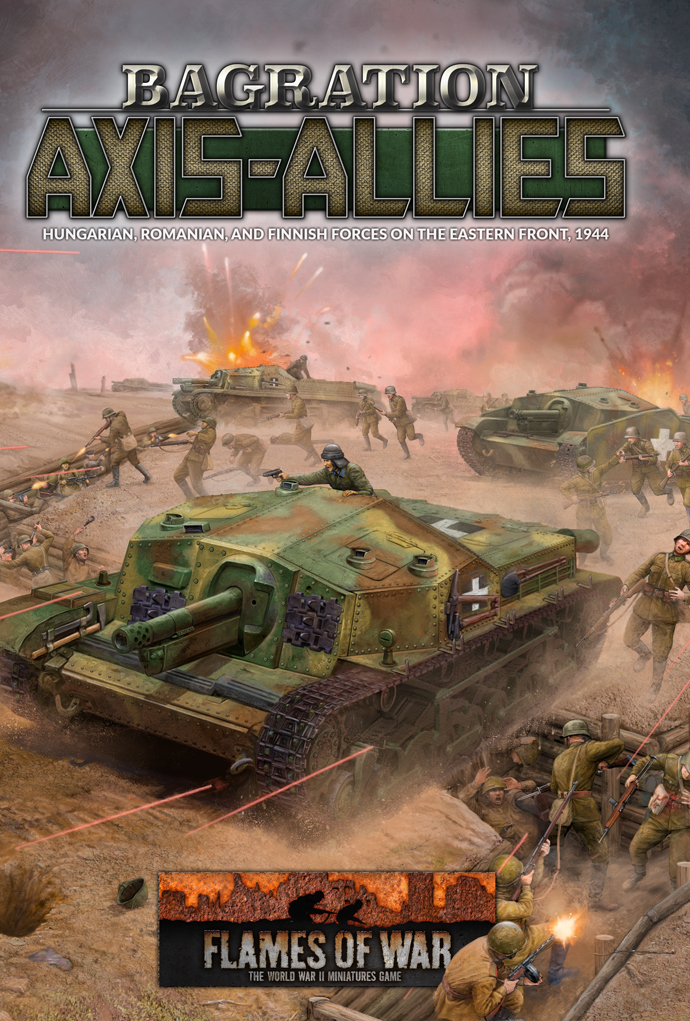 |
Battery Of The Dead:
Battery Of The Dead: A Flames Of War Scenario
by Wayne Turner
On 26 September 1944 at the village of Királyhegyes, near the Hungary-Romanian border, the Hungarian 2nd Battery of the 7th Assault Gun Battalion (7. Rohamtüzérosztály) engaged the tanks of the Soviet 18th Tank Corps. During the battle they knocked out twelve T-34 tanks, but lost all nine of their StuG G assault guns in the process earning the nickname The Battery of the Dead.
Learn about Bagration: Axis Allies here...
|
2nd Battery, 7th Assault Gun Battery
Transylvania 1944
The story of the second ‘Battery of the Dead’ began on 24 September 1944. The Red Army’s 799th Rifle Regiment had occupied the village of Csanádpalota on the Transylvanian border after chasing out a small force of border guards, gendarmes and anti-aircraft troops.
The Hungarian division in the area was the 8th Reserve Infantry Division, and in support they had the 7th Assault Gun Battalion. The 2nd Battery had just arrived in the area with their new StuG G assault guns. |
 |
Battery Commander
The battery was under the command of 24-year old Lieutenant Barnabás Kőszeghy, mounted in assault gun ‘700’. He was assigned to the 7th Assault Gun Battalion in September after his recent marriage. However, he did not miss out on the action for long. His transfer led to a period of training in Germany on StuG G assault guns, before his battery was finally sent to the Hungarian Third Army front. |
Soviet Surprise Attack
On the morning of 25 September the battery was assigned to retake the village of Csanádpalota and cut Soviet supply lines. At about 0800 hours Kőszeghy’s battery was ready to attack. A battalion from the 12th Reserve Infantry Regiment assigned to support them was still making preparations for the attack when a Soviets attack overran their positions at 1000 hours, scattering the assembling infantry.
Right: ‘Officer to the Hungarian Order of Merit with War Decoration’ medal as posthumously awarded to Lieutenant Barnabás Kőszeghy for his actions at Rákóczi Csárda. |
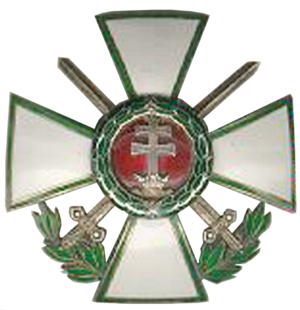 |
Counterattack on Csanádpalota
Kőszeghy’s 2nd Battery, 7th Assault Gun Battalion, launched an immediate counterattack. They faced a unit of T-34/85 tanks from the Red Army’s 18th Tank Corps. They knocked out a T-34 tank and forced three to retreat. They were joined in their attack by a company of the 12th Reserve Infantry Regiment under Lieutenant Vilmos Bondor. In a space of about 20 minutes they had pushed Soviets back 12 kilometres.
A report received by Lieutenant Bondor the previous night indicated Csanádpalota was not very strongly held. A few anti-tank guns on the village’s northern outskirts and some tanks undergoing repairs in the village square was all that defended it. |
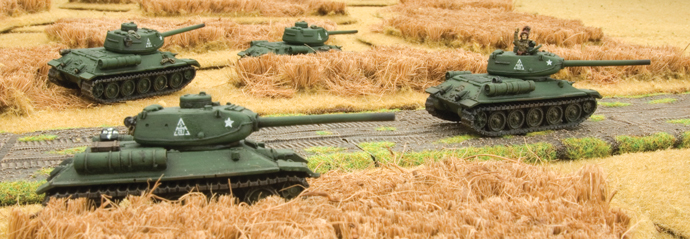 |
| Supported by the assault guns, the infantry attacked the village and quickly advanced to the square where they took the Soviet command post. Bondor was later commended for his courage as he took part in the assault to take the village. He ignored the enemy tanks to get behind anti-tank and machine-gun positions, taking part in assaults to take out the nests one-by-one. Many Soviets fled and abandoned their equipment. Those that resisted retreated into the houses and fought from them. The battle for the village took 30 minutes, and by 1130 hours the Hungarians were back in possession of Csanádpalota. |
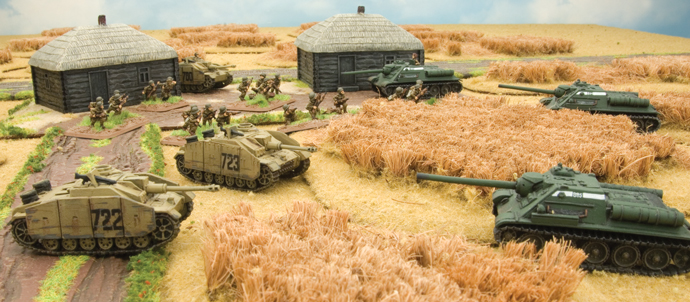 |
Soviet prisoners were herded into the village church and the infantry went about sweeping the area for more enemy. Many of the Red Army soldiers loitered drunk in the streets, making them easy to round-up. The Hungarian casualties were just one killed and three wounded. One assault gun was damaged. The Soviets lost 13 T-34 tanks, four anti-tank guns and 23 prisoners taken.
News soon arrived that the Red Army was advancing on the southwest flank and the Hungarian victors of Csanádpalota prepared for a Soviet counterattack. 8th Reserve Infantry Division ordered all troops to withdraw, except the battery of assault guns and the III Battalion, 12th Reserve Infantry Regiment in Csanádpalota. |
 |
Battery Of The Dead
Red Army T-34 tanks of the 18th Tank Corps and SU-85 assault guns of the 1438th Assault Artillery Regiment were
attempting to outflank the Hungarians at Királyhegyes. However, the 2nd Battery’s counterattack headed off their move.
The battle was fought in the failing light of evening and the area was extensively covered in cornfields that further limited visibility of the enemy.
The fighting was fierce, with the vehicles closing to ranges as close as 20 metres. Lieutenant Barnabás Kőszeghy and his assault gun crew had just destroyed three T-34 tanks when he was hit and mortally wounded while directing his battery from his cupola. Despite his wounds he continued to fight and Assault Gun ‘700’ knocked out two more T-34 tanks before a fire in the damaged assault gun set off the ammunition and killed Kőszeghy and his crew. During the chaotic battle all nine of the 2nd Battery’s StuG G assault guns were destroyed, damaged or abandoned. The III Battalion, 12th Reserve Infantry Regiment fared much better and extracted themselves from Királyhegyes with just 28 killed, but lost most of their heavy equipment.
|
 |
Aftermath
When the village was recovered a few days later twelve knocked out Soviet T-34 tanks were found scattered about the battlefield.
Eight Hungarian assault guns were found relatively intact. Investigation showed that the rest of Kőszeghy’s assault gun crews may have abandoned their vehicles after his death. Twelve other assault gun crewmen lost their lives in the battle.
The III Corps artillery commander’s report says the Soviets clashed with the 2nd Battery at about 1830 hours, where three assault guns were knocked out and Kőszeghy killed. The report goes to say that Kőszeghy was too reckless and should have stayed in Királyhegyes and not attacked to the east at Rákóczi Csárda.
Despite this, Lieutenant Barnabás Kőszeghy was posthumously made an ‘Officer to the Hungarian Order of Merit with War Decoration’, one of Hungary’s highest honours. |
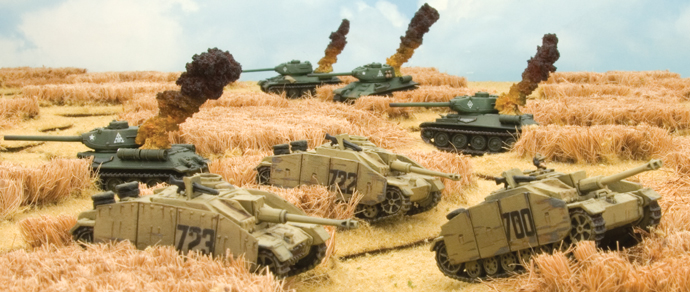 |
The Battery Fights On
In the aftermath five StuG assault guns were repaired after recovery and the 2nd Battery continued to fight as an effective unit. Under the command of Captain Pál Török the 7th Assault Gun Battalion took part in the battle for Kecskemét alongside the 24. Panzerdivision. They fought around Budapest, before ending up inside the besieged city where they fought until it finally fell in February 1945. |
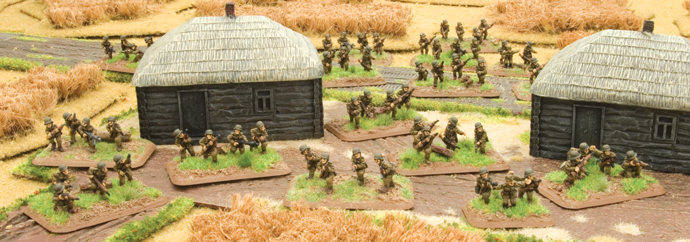 |
The Original Battery of the Dead
The term ‘Battery of the Dead’ is a name borrowed from the 1866 Austro-Hungarian war against Prussia. The original ‘Battery of the Dead’ was the Imperial Army’s 7th Horse Battery, 8th Artillery Regiment, which consisted mainly of Hungarians. On 3 July 1866, during the withdrawal from the battle of Königgrätz, the original Battery tried to stop the breakthrough of the Prussian Guards to buy time for other units to withdraw. An Austrian Jäger (sharp shooter or rifle) battalion was locked in hand-to-hand with the Prussians, their line of retreat blocked. The battery rushed to their aid, unlimbering just 150 metres from the Jägers and poured case shot into the Prussians. However, due to withering fire coming from the Prussians’ new breach-loading rifles their shooting was cut short. The tremendous return fire of the Prussians killed the battery commander, Captain Augustus van der Groen, and 53 of his men in a space of five minutes. Only one gun was saved. Captain Groen was later made a knight of the Order of Maria Theresa for his the self-sacrificing acts during the action. |
| Battery Of The Dead Scenario |
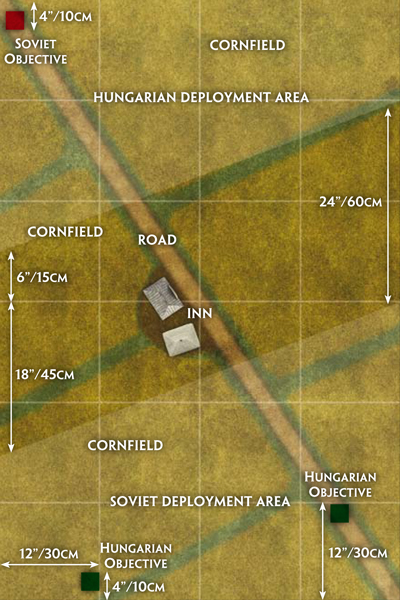 |
The Battery of the Dead scenario uses the Meeting Engagement, Dusk Fighting and Delayed Reserves special rules.
Your Orders
Hungarian
You have launched a pre-emptive strike against the advancing Red Army tanks. Your plan is to catch the by surprise and to blunt their spearhead and give your infantry time to prepare defences.
Soviet
You tanks are advancing into Hungary as part of a general offensive. You are to drive through the Hungarians and make your way deep behind enemy lines.
Setting Up
Set up terrain using the map as your guide.
Place the Soviet and Hungarian Objectives as identified on the map.
Deployment
The Soviet defender then deploys their forces in Soviet deployment area except the T-34 (85mm) Tank Company in Delayed Reserves.
The Hungarian player deploys their force in the Hungarian deployment area.
The Hungarian player has the first turn.
|
|
Winning the Game
A player wins if they end their turn Holding one of the Objectives on the opponent’s side of the table.
If the Hungarian player wins they have forced the Soviet back and brought time for the 8th Reserve Infantry Division to redeploy.
If the Soviet player wins they have smashed through the enemy counterattack and can continue their drive into Hungarian territory!
|
Terrain
The Hungarians attacked in the evening through the cornfields that covered most of the farmlands of the area.
Cornfields are Short Terrain, concealing teams in and behind them. However, for Dash movement it counts as Cross-country.
An inn is positioned along the road. A substantial building that offers Bullet-proof Cover.
Dusk Fighting
When the battle at Rákóczi Csárda began it was the evening and it was still light. However, by the end of the encounter darkness had fallen.
At the start of the Soviet defender’s turn three, roll a die.
- On a score of 5+, night has fallen.
- If the roll is unsuccessful, the Hungarian attackers rolls two dice at the start of the start of turn four. If it is still daylight at the start of the Soviet defenders next turn, they roll three dice, and so on until night falls on any roll of 5+.
The turn night falls, the Night Fighting rules (page 113 of the rulebook) come into effect for the remainder of the game.
Download a PDF version of the Battery Of The Dead Scenario here...
Learn how to build the Battery Of The Dead table here... |
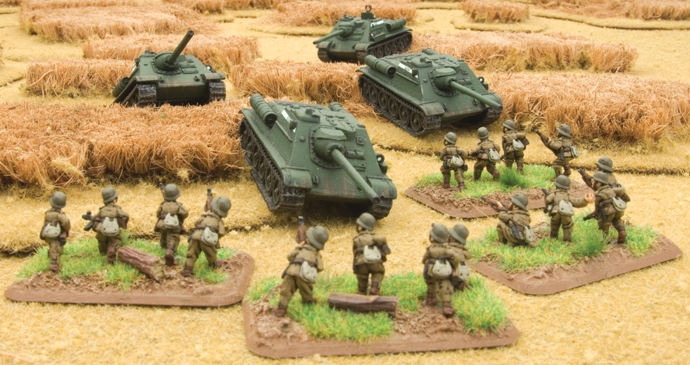 |
| Scenario Forces |
| Hungarian Force |
| 2. Üteg, 7. Rohamtüzérosztály |
Rohamágyús Üteg |
| (2nd Battery, 7th Assault Gun Battalion) |
(page 60, Bagratin: Axis Allies) |
Föhadnagy Barnabás Kőszeghy
|
StuG Assault Gun Battery HQ (LH114)
1x StuG (7.5cm)
Barnabas Kőszeghy command card
|
1st Platoon, 2. Üteg
|
StuG Assault Gun Platoon (LH115)
3x StuG (7.5cm)
|
2nd Platoon, 2. Üteg
|
StuG Assault Gun Platoon (LH115)
3x StuG (7.5cm)
|
3rd Platoon, 2. Üteg
|
StuG Assault Gun Platoon (LH115)
3x StuG (7.5cm)
|
| Supported by |
|
| III Zászlóalj, 12. Tartalék Hadosztály |
|
| (III Battalion, 12th Reserve Infantry Regiment) |
|
| Puskás Platoon |
Rifle Platoon (LH120)
10x 31M MG & 95M rifle team with Panzerfaust
|
| Puskás Platoon |
Rifle Platoon (LH120)
10x 31M MG & 95M rifle team with Panzerfaust
|
|
| 18ya Tankovy Korpus |
T-34 (85mm) Tank Battalion |
| (311ya Tankovy Batalon) |
(Page 52, Bagration: Soviet) |
Podpolkovnik Ivan Kolesnikov
|
T-34 (85mm) Tank Battalion HQ (LS178)
1x T-34 (85mm)
|
1ya Tankovy Rota
|
T-34 (85mm) Tank Company (LS179)
10x T-34 (85mm)
|
1438ya Samokhodnaya Artelleria Polk, 1ya Rota
|
SU-85 Tank-killer Company (LS144)
5x SU-85
|
| |
Delayed Reserves |
2ya Tankovy Rota
|
T-34 (85mm) Tank Company (LS179)
10x T-34 (85mm)
|
|
| Sunset, 27 September 1944. |
As the sun sets and the golden light plays across the corn fields, Lieutenant Barnabás Kőszeghy’s battery of StuG assault guns advances through the withered stalks determined to halt the advancing vanguard of the Red Army’s 18th Tank Corps.
The corn is high, but the muzzle blasts from StuG assault guns, T-34/85 tanks and SU-85 tank killers has cut swaths through the crops. The battle is evenly poised, Kőszeghy’s men have knocked out several T-34/85 tanks and SU-85 tank killers, but not without casualties of their own.
The balance was about to be tipped. The second company of T-35/85 tanks has arrived and advances up the road…
~ Wayne. |
Last Updated On Wednesday, December 22, 2021 by Wayne at Battlefront
|
|
|